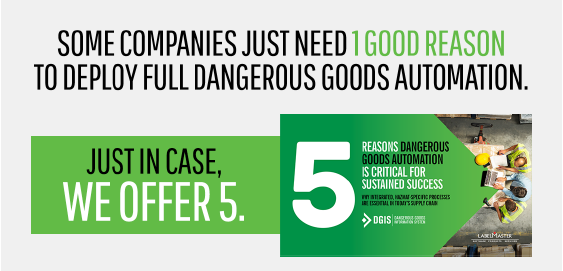

Week of May 2, 2022
Linking supply chain news with dangerous goods compliance
Demand for pharmaceutical goods continues to increase, even as businesses are forced to navigate ongoing supply chain challenges.
Let’s examine some recent industry news.
SUPPLY CHAIN NEWS
- Automation to Drive the Innovative Pharmaceutical Industry Forward: With the growing challenges facing the pharmaceutical industry, it is becoming necessary to increase automation.
- How AI is Helping the Supply Chains in the Healthcare Sector: AI can not only analyze large amounts of data to identify patterns and hidden correlations quickly, but it can also be fed with a wide range of variables, which gives the engine more flexibility in its analysis.
- Healthcare Orgs Struggle with Software Supply Chain Risk Management Policies: The majority of surveyed healthcare organizations said that they had not fully implemented software supply chain risk management policies.
- The Top 25 Global Logistics Providers: The support of third-party logistics firms has become more important as the demand for medical supplies and other goods has increased. Here’s a look at the top 25 logistics providers operating today.
- Groups Target Communications, Pharma Risks with New Healthcare Resources: Two healthcare groups issue new resources to support security leaders with communicating device vulnerabilities and better understanding pharmaceutical supply chain risks.
- The Next Big Digital Revolution is Happening in the Pharma Industry: Digital revolution is all about creating seamless connectivity between machines, processes and the people within and beyond manufacturing facilities to increase, quality, productivity and profit from the power of advanced data analytics.
OUR PERSPECTIVE
- Pharmaceutical goods can be dangerous. High demand for pharmaceutical goods has put added pressure on businesses to expedite the shipment process, especially given the urgent need for safe, fast, reliable transport of specimens, vaccines, medicines and medical devices around the globe. Many of which are classified as dangerous goods and, as a result, bring additional regulatory requirements and supply chain challenges.
- Supply chain delays put goods and patients at risk. A wide range of factors can impact the transport of temperature-controlled pharmaceutical goods. Incorrect or non-compliant packaging, labels, markings or documentation can result in delays. For pharma companies, delays can cause specimens and medications to be ruined, while putting patients at the end of the supply chain at risk.
- Rules vary by where and how goods are shipped. Differences in packaging requirements and shipping regulations exist between countries and transportation modes. Ensuring that hazmat shipments are fully compliant requires that both the item being shipped (e.g., vaccine, specimen, etc.) and what those items are shipped with (e.g., data logger containing a lithium battery, dry ice, etc.) comply with regulations of both the origin and destination countries and the mode being used.
To learn more about Dangerous Goods software or how to establish a safer, more compliant supply chain, visit https://www.labelmaster.com.
Have questions about Dangerous Goods transport? Call the Labelmaster Regulatory Hotline at 1.800.621.5808.
Automation is the key to handling today’s supply chain challenges. But without true Dangerous Goods automation, you may be operating at a competitive disadvantage.
Integrating Labelmaster’s DGIS with your existing TMS, ERP, WMS or OMS platforms puts Dangerous Goods information in the same window as all your other shipping information. Hazmat shipments become as simple as non-regulated shipments—a seamless part of your normal workflows.
Our new eBook explains how integrating DGIS with your existing automation platforms can help your organization sustain success in today’s supply chain.




